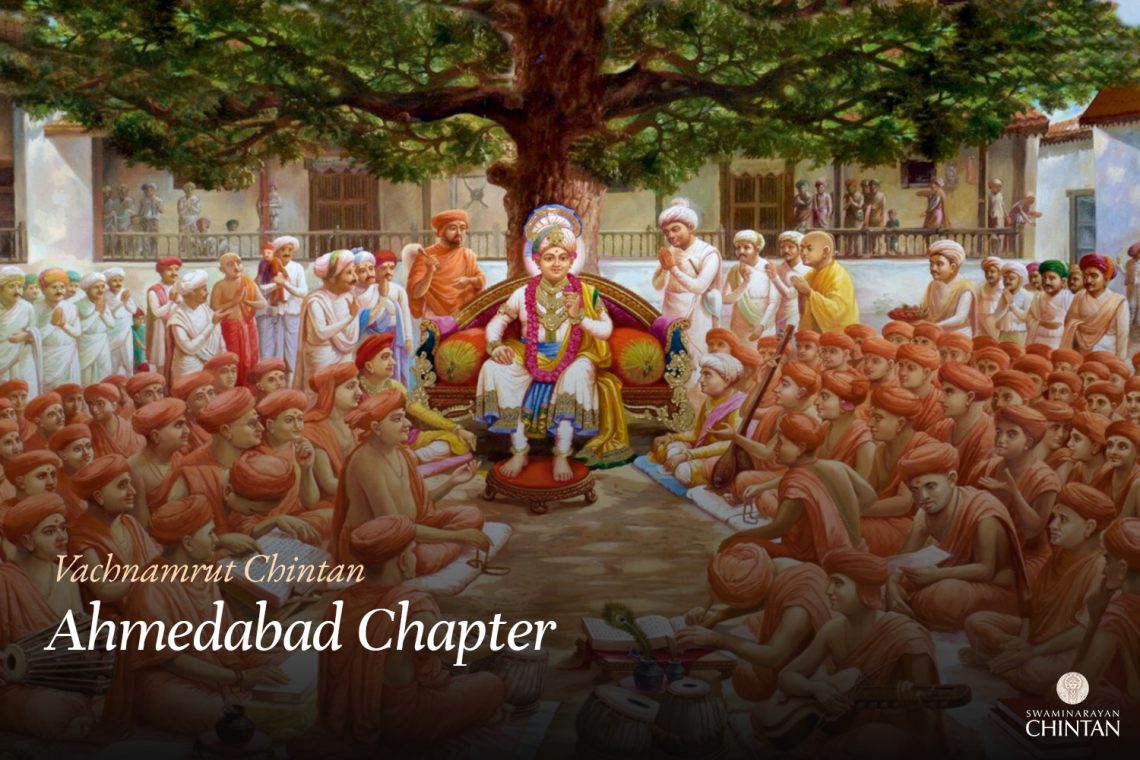Central Insights:
- Transcending the three gunas (modes of material nature) and three states of consciousness to worship Bhagwan.
Key Points:
- Compared to qualities like Atmanishtha (steadfastness in the self), Bhakti (devotion) is the supreme quality.
- The purity of Bhakti is more significant than its intensity.
Explanation:
In this Vachanamrut, Shreeji Maharaj poses a question: A devotee who transcends the three states—wakefulness (jagrut), dreamful sleep (swapna), and deep sleep or dreamless sleep (sushupti)—as well as the three gunas—sattva, rajas, and tamas—and worships Paramatma (the supreme being), is compared with another devotee who, despite being bound by the three gunas, is deeply attached to and filled with love for Paramatma. Among these two, who is the superior devotee?
When the saints answered that the one filled with love for Bhagwan is superior, Shreeji Maharaj perceived that their response did not fully capture the essence of the question. To clarify, Maharaj rephrased the question, maintaining the same intent: “One person worships Bhagwan after cleansing himself thoroughly, while another worships while unclean, being covered in waste and urine. Who among these two is superior?” The saints replied that the one who worships after becoming clean is superior.
Here, the saints’ responses to the seemingly different questions appeared contradictory. On deeper reflection, it becomes clear that the saints initially believed that love and Bhakti for Paramatma are of utmost importance, surpassing all other qualities like Vairagya (detachment) or Atmanishtha. They reasoned that even if one possesses Vairagya or Atmanishtha, without Bhakti or love for Maharaj, they are incomplete. However, the essence of Shreeji Maharaj’s question lay in comparing two forms of Bhakti itself, rather than Bhakti against other qualities. This became evident through Maharaj’s clarification in His response.
One type of devotee transcends the influence of the three gunas and three states of consciousness, offering pure Bhakti to Maharaj. The other devotee remains subject to these influences, even if they appear to possess profound Bhakti. Their devotion is interwoven with dependency on these material conditions. On the other hand, the first devotee’s Bhakti is purely under the influence of Paramatma, free from material taints. This is considered siddhantik bhakti (devotion aligned with spiritual principles). Shreeji Maharaj elaborates on this kind of devotion in Vach.G.M.43.
In general, Bhakti is regarded as superior to other qualities like Vairagya or Atmanishtha. However, once one has established themselves on the path to Bhagwan, the purity of Bhakti takes precedence over its intensity. Such pure Bhakti is what Maharaj refers to as supreme, and this aligns with the principles of the scriptures as well.
Thus, Maharaj and the scripture writers emphasize that Bhakti, purified of all material influence, is the highest form of devotion.
Glossary
| Atmanishtha – Steadfastness in the realization of the soul The firm realization and understanding of the soul’s true nature, living beyond the influence of three kinds of body |
| Bhakti – Devotion Loving and selfless worship of God. |
| Vairagya – Detachment From Everything Except God |
| Jagrut – Wakeful state The state of being fully awake and conscious, in which the soul perceives the external world and engages with it. |
| Swapna – Dream state A state of consciousness during sleep where one experiences dreams, often linked with Rajasi happiness, characterized by desires and distractions. |
| Sushupti – Deep sleep The state of unconsciousness or deep sleep, where the mind is not active, and the individual does not experience desires. |
| Sattva – Purity, goodness, and harmony One of the three gunas (attributes) in nature, characterized by purity, knowledge, and tranquility. It is the quality of mind that leads to spiritual wisdom and devotion. |
| Rajas – Passion, activity, and attachment One of the three gunas, associated with desire, action, and worldly attachments. It clouds the mind, leading to distractions and hindrances in spiritual progress. |
| Tamas – Darkness, ignorance,and inertia One of the three gunas, associated with ignorance, lethargy, and spiritual dullness. It causes attachment to illusion and leads to suffering and delay in spiritual realization. |
| Siddhantik Bhakti – Devotion aligned with spiritual principles The pure form of Bhakti, free from material influence, and aligned with the spiritual principles of devotion to Bhagwan. It is considered the highest form of devotion, transcending worldly attachments and distractions. |

